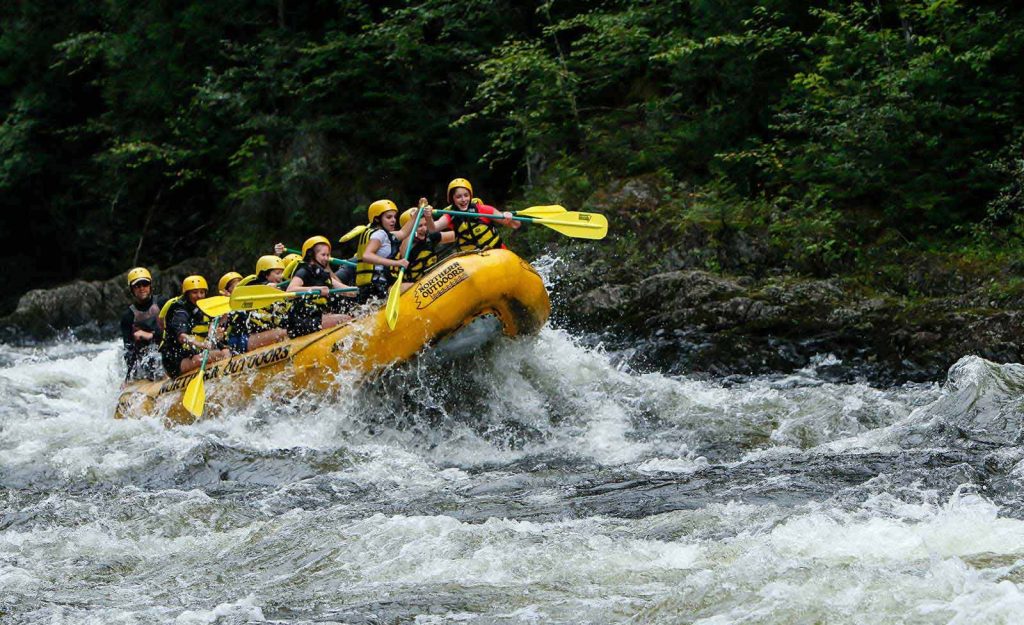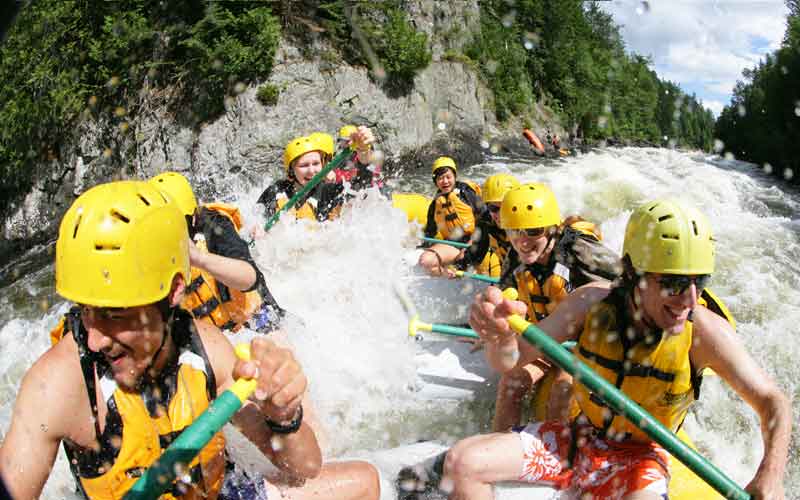5 Essential Rafting Tips for Beginners
If you’re going whitewater rafting for the first time, you probably have a few questions mixed in with all of your excitement. What do you do if you fall out of the raft? What should you expect from your guide? Is whitewater rafting safe? (Or, at least, your mom has been asking those questions.)
We get a lot of first-time rafters on our trips, and our guides love making sure everyone has an awesome day of adventure. Here are a few beginner whitewater rafting tips to help you know what to expect on your first trip!
1. Dress appropriately.
One of the first things you’re probably wondering is what to wear whitewater rafting. For shoes, you’ll want something that stays on your feet–definitely no flip-flops. An old pair of sneakers, water shoes, or river sandals work well.
For clothes, avoid cotton T-shirts because they pull heat away from your body. And don’t be that guy that shows up in jeans. (I promise, you will get soaked.) On warm summer days, I typically wear quick-drying sports shorts and a tank top over a bathing suit. But Maine also sees its share of cool or cold days throughout the rafting season, and materials like wool, polar fleece, and fiber pile work well to keep your body heat in. Depending on what time of year you go rafting in Maine, you may also need a wetsuit (we offer these for rent to all our rafters).
Check out our rafting FAQs for even more details on what to wear for your whitewater rafting adventure in Maine.
2. Keep your life jacket and helmet secured at all times.
Before you drop the raft into the rushing current, your guide will make sure your life jacket and helmet are secured properly. Keep in mind, these are not your grandpa’s life jackets that you used to wear on fishing trips as a kid. (Remember those ones that rested on your neck with a flimsy strap tied around your waist?)
The life jackets you’ll wear on a whitewater rafting trip with Northern Outdoors are heavy duty and Coast Guard-approved. It will feel extremely snug at first, and that’s how it’s supposed to be. Why? If you fall out of the raft, your guide or someone in your group may need to pull you back in by your life jacket, which means it’s absolutely essential that it fits you securely.
3. Be prepared for a workout.
It’s not just the guide’s job to power the raft. Everyone will be digging their paddles in hard (or risk being called out for “lilly dipping”), so come ready for an arm workout. You don’t have to be an athlete or an experienced rafter, but you should be in reasonably good health to be able to help power the raft with the rest of your group.
That hot tub at the lodge will be calling your name by the end of the day!
4. Know the proper way to swim.
If you find yourself in the water (voluntarily or otherwise), it’s important to keep your feet up at all times so that they don’t get caught on a rock on the bottom of the river. Assuming the “swimmer’s position” is pretty simple–lay on your back, feet up in front of you, and face downstream. If you need to swim facing forward, simply roll over, keeping your feet up, and turn your body in the direction you need to swim.
And although I’m pretty sure Maine rivers are some of the cleanest around, you probably don’t want to drink too much water as you’re getting back to the raft. Try to remain calm and take short, timed breaths to avoid swallowing water. Remember that your guide is well trained and will guide you to safety as quickly as possible.
Don’t worry, your guide will go over all of this before your trip!
5. Trust your guide.
If there’s one thing I’ve learned from a couple decades of rafting, it’s that trusting your guide is absolutely essential. You might feel a nervous rush as you make your way down to the river, surrounded by hundreds of other adventure seekers (I still do, every time!). But you won’t head into the rapids unprepared.
Our guides will give you an orientation before you get into the river, which includes their paddling commands, what to do if you fall out of the raft, and other safety instructions. Pay attention to their instructions, and don’t be afraid to ask questions if you don’t understand something.
Your guide is a licensed expert, who has gone through extensive guide training, and wants you to have a safe–and fun–experience. Trust them, and get ready for a day of adrenaline and whitewater!

Experienced whitewater rafters, add your tips for beginners below and share with the friends who would enjoy a day on the river!


